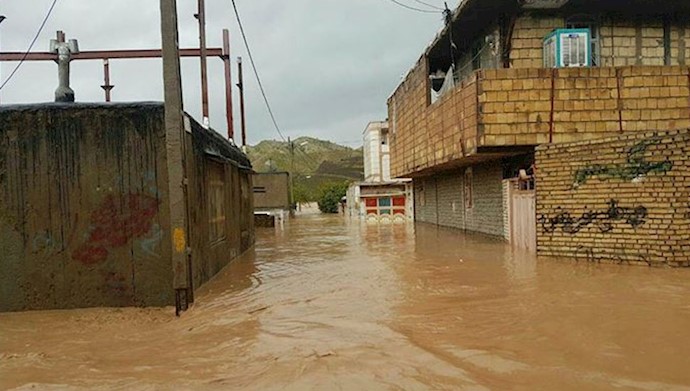Reported by PMOI/MEK
Iran, April 2, 2019 – Many cities across Iran, especially the provinces of Lorestan and Khuzestan, witnessed massive flooding on Monday. The capital city Tehran, also saw rising floodwaters levels as the incompetence and corrupt policies implemented by the mullahs’ regime and the IRGC continue to wreak havoc across the country.
Floodwaters have ruined people’s lives and destroyed their homes. A small child asks, “Mom, mom, which one is our house?”
Floodwaters have also devastated villages and the farmlands around the city of Shush, southwest Iran.
Waters of Dez River is reportedly flowing from the city of Hor into Haft Tapeh of Khuzestan Province, southwest Iran.
With the city devastated, the first signs of relief were seen entering the city at around 5 am local time.
Fifty-four major roads and highways across the country are reportedly blocked due to floods and landslides. The main road from Ahvaz, the capital of Khuzestan Province, to Abadan, located on the southwest tip of Iran near Iraq and Kuwait, is blocked due to rising levels of Karun River.
The roads of Haraz and Chalus leading north from Tehran, the country’s capital, remain blocked. Rivers in this area are also on the verge of overflowing.
The governor of Khuzestan Province is ordering 71 villages to evacuate; of which 44 villages have completely evacuated, 10 villages are evacuating and the remaining 17 are in dangerous conditions. Locals are complaining that authorities are providing no place for refuge and only issuing evacuation orders.
The central cities of Mazandaran Province, northern Iran bordering the Caspian Sea, are facing threats of floods. A number of villages near the cities of Babol and Savadkuh have been evacuated. Rivers near other cities of the province are reportedly overflowing rapidly.
Many dams across the country have overflowed, some are showing signs of dangerous cracks and nearly all are reporting escalating water pressures.
Landslides are also seen as a major threat across the country. An official of the regime’s Red Crescent said the Tehran-Ahvaz railway is blocked due to landslides. A train carrying 300 passengers on this track had to be stopped.
Around 20,000 hectares of farmlands in the town of Sahne in Kermanshah Province, western Iran, have been destroyed because of floodwaters. Rising waters have actually engulfed 42 of the 53 villages facing floods. 125 millimeters of rain has been reported in the past two days.
Iranian opposition President Maryam Rajavi, head of the National Council of Resistance of Iran (NCRI), has issued a message describing recent developments as a national catastrophe. The mullahs’ regime in Iran must allocate all state assets to provide emergency relief to the people.
The resources of the Revolutionary Guard Corps, Army and the government must be placed at the disposal of people. The regime must open the way for international relief efforts. However, it has so far obstructed national cooperation and international aid. #IranFloods #Iran
— Maryam Rajavi (@Maryam_Rajavi) April 1, 2019
An NCRI statement in this regard reads:
Devastating floods have once again affected vast regions of Iran, particularly the provinces of Khuzestan, Lorestan, and Ilam, submerging scores of cities and hundreds of villages under floodwaters. The criminal and corrupt ruling mullahs have not undertaken the least measures to counter the catastrophic impact of the flood, despite forecasts of heavy rain in these regions. People in many cities and villages were forced to flee their homes with no temporary shelters prepared for the vast number of victims by the ruling regime.
The regime’s head, Khamenei has kept mum on the destructive floods and the catastrophic consequences, while other authorities such as Larijani and Rohani as well as cabinet members and IRGC commanders stoke public anger by treating the disaster as a photo op in visits to flood-stricken regions.
Parliament member from Ahwaz, Javad Khazem-Nasab, called Rouhani’s visit to Khuzestan fruitless, claiming the government has sent “mostly weary and faulty machinery” to Khouzestan, adding that “lack of waterway dredging and management” have led to these floods.
The situation in Iran’s northern regions and Golestan province and in cities like Agh-Ghola and Gomishan remains critical, despite two weeks since the beginning of floods in those regions. The regime has not undertaken minimum measures to resolve problems stemming from the flood and victims can only count on popular relief action.
Mrs. Rajavi called on the Iranian nation once again, especially the youth, to form popular councils for independent relief action to bring aid to the flood victims, especially in Khuzestan, Lorestan, and Ilam. She pointed out that while the mullahs have no concern other than maintaining their shameful rule and plundering the nation, the only way to counter flood effects was national solidarity.
She added that the mullahs are responsible for leaving the country defenseless in face of natural disasters by destroying the environment with irreparable deforestation, huge embezzlements, and wasting Iran’s resources for repressive, terrorist and warmongering ends, and must be held accountable for the countless victims and millions of refugees caused by the recent floods.





